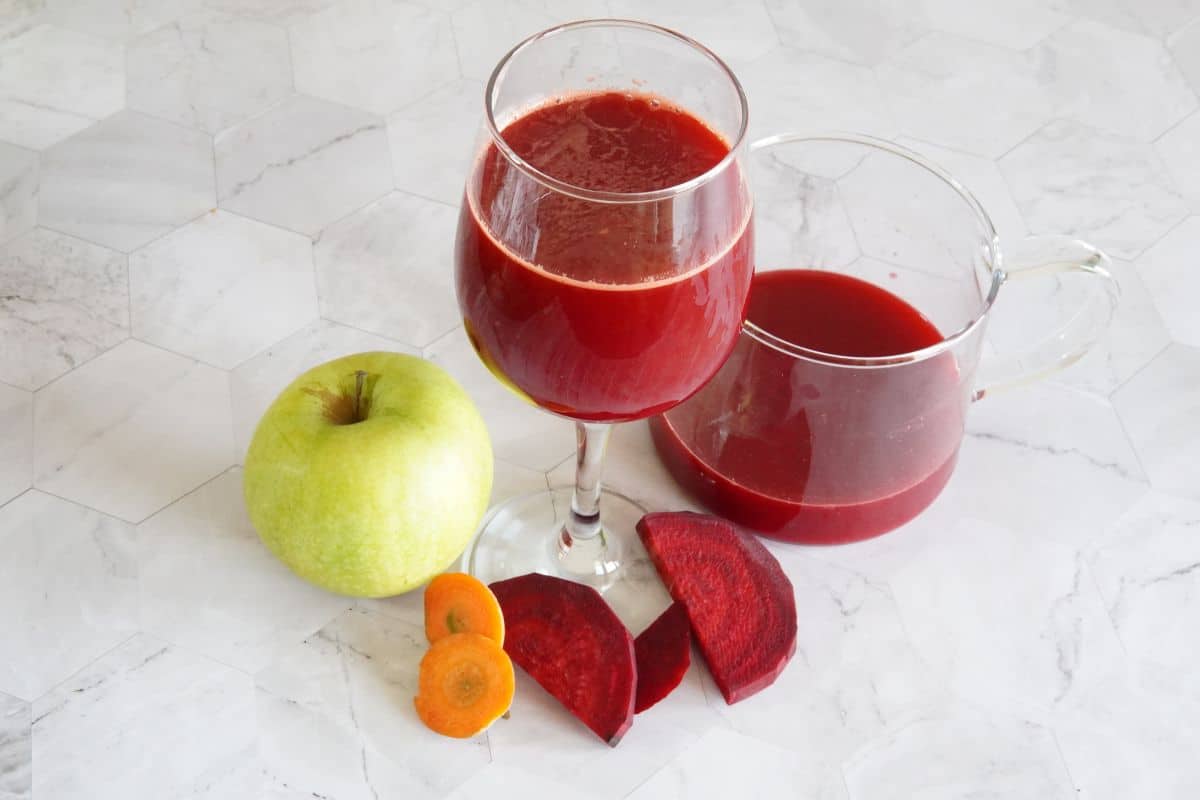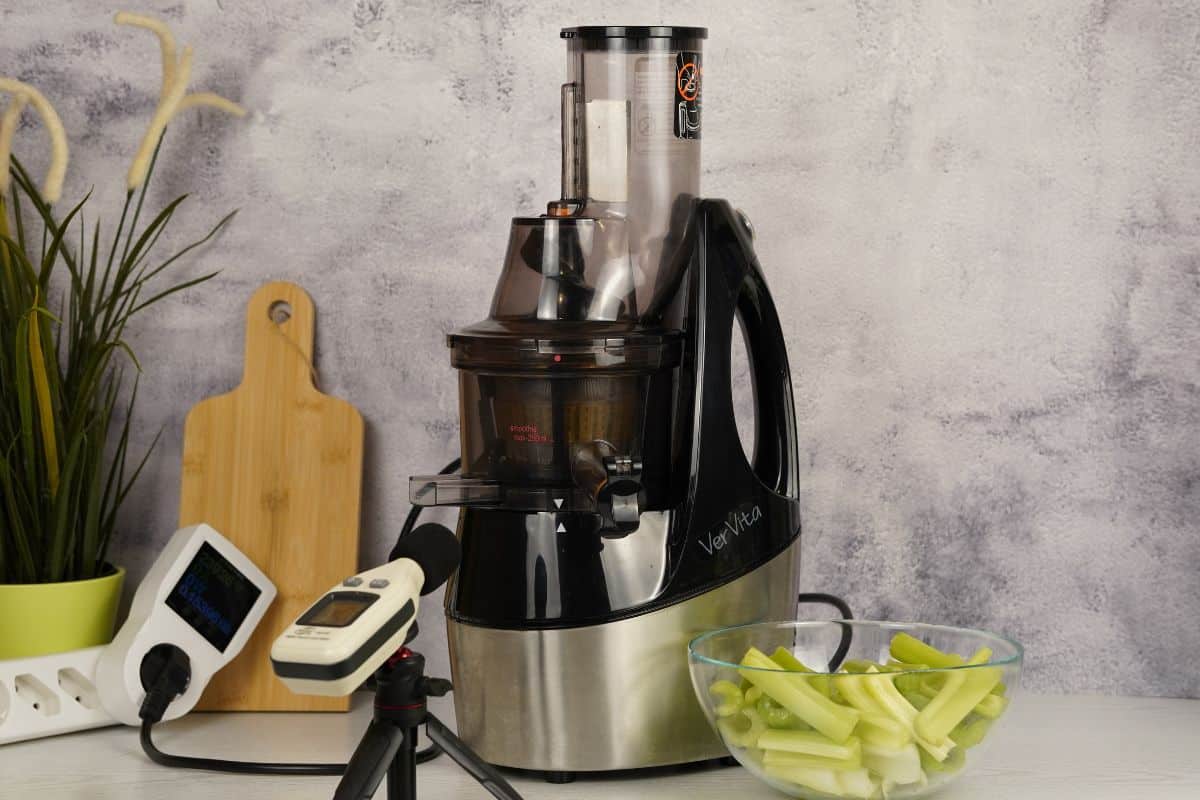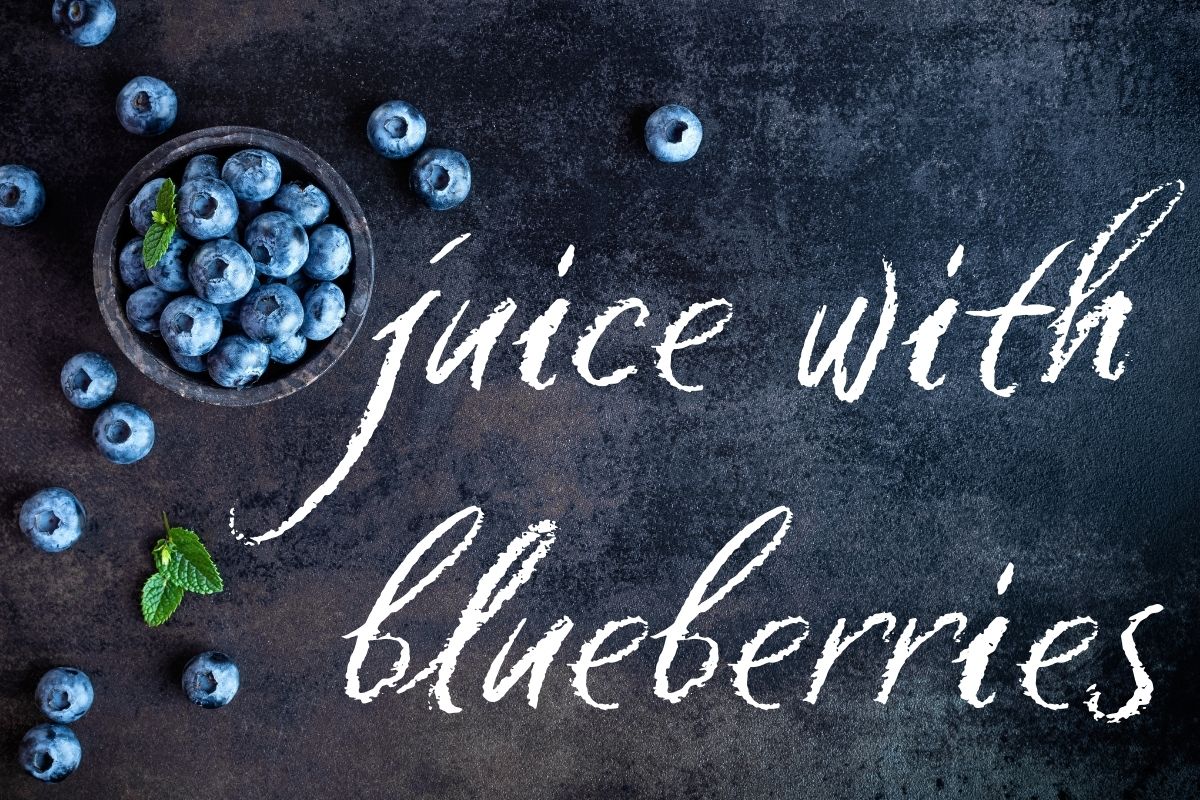What’s new:
• Updated values for H320N / H330P
As an electrical engineer passionate about juicing, I’ve spent the last 4 years testing countless juicers – and finding the best slow juicer for celery has been one of my main focuses. I’ve rigorously tested various Hurom models specifically for celery juice extraction, going beyond marketing claims to bring you real performance data based on multiple trials. If you’re looking for an honest, data-driven comparison to help you choose the best slow juicer for celery, you’ve come to the right place.
Why Focus on Celery Juice?
The celery juicing movement, popularized by Medical Medium, has gained significant traction for its potential health benefits. The recommendation is to drink 16oz (470ml) of pure celery juice first thing in the morning on an empty stomach. This makes having a reliable, efficient juicer specifically good at handling celery particularly important.
Testing Methodology
My standardized testing protocol ensures consistent, reliable results:
- Input quantity: 500g celery per test
- Cutting size: 4-6 cm pieces
- Multiple trials per juicer (minimum 3)
- Controlled testing conditions
- Precise measurements using:
- Calibrated measuring cups for yield
- Decibel meter for noise levels
- Watt meter for power consumption
- Digital scale for pulp weight
Measured Parameters
Juicer Ratings
How I Rate and Compare Celery Juicers:
Based on juice color and oxidation indicators:
Minimal oxidation (fresh, bright natural color): 10 points
Moderate oxidation (some color changes): 5 points
High oxidation (significant browning/darkening): 0 points
Based on the difference between raw and strained juice yield:
Excellent (≤2.5% difference): 20 points
Very Good (2.51-3.5% difference): 16 points
Good (3.51-5.0% difference): 12 points
Fair (5.01-7.0% difference): 8 points
Poor (>7% difference): 4 points
Calculated as percentage of best performer
Score = (Juicer’s yield / Highest yield) × 10
Calculated as percentage of best performer
Score = (Juicer’s strained yield / Highest strained yield) × 10
Under 2:00 minutes: 20 points
2:00-2:30 minutes: 15 points
2:31-3:00 minutes: 10 points
3:01-4:00 minutes: 5 points
Over 4:00 minutes: 0 points
Under 2:00 minutes: 20 points
2:00-2:30 minutes: 15 points
2:31-3:00 minutes: 10 points
Over 3:00 minutes: 5 points
Under 2:00 minutes: 20 points
2:00-2:30 minutes: 15 points
2:31-3:00 minutes: 10 points
Over 3:00 minutes: 5 points
Best Slow Juicer for Celery Overall: Hurom H320N/H330P
The Hurom H320N and H330P demonstrated identical performance in my testing, which isn’t surprising given they share the same internal technology. While these models registered the highest noise levels (78 dB) and longest cleaning times (2:41), they consistently produced the clearest, brightest celery juice with minimal oxidation. The juice yield is impressive at 356ml from my standardized 500g celery test, with almost no difference between raw and strained yields (356ml vs 355ml), indicating exceptional filtration.
Fastest From Start to Finish: Hurom H400
While the H320N/H330P juices slightly faster, the H400 is the most time-efficient overall. With a juicing time of 2:32 and quick cleanup of just 1:51, you’ll complete the entire process in 4 minutes and 23 seconds – the fastest total time among all tested models. Perfect for busy mornings when every minute counts.

Easiest to Clean: Hurom H310A/H400 (Tie)
Both the H310A and H400 share the fastest cleanup time of 1:51, significantly quicker than other models. However, they offer different trade-offs – the H310A has a smaller feeding tube requiring more prep time, while the H400 produces slightly less juice yield.

Highest Initial Juice Yield: Hurom H310A
The H310A produces the highest initial yield at 384ml, but there’s a technical reason behind this. Its narrower pulp exit tends to clog unless celery stalks are cut into very small pieces.
This partial clogging actually forces more intense squeezing of the celery, resulting in higher juice extraction (384ml initial yield) but also introducing more pulp (364ml after straining).
While this leads to impressive yield numbers, it comes with two major drawbacks: a significantly longer juicing time (5:58) and the need for extra prep work to cut celery into smaller pieces.

All juicers explained
Hurom H320N/H330P

These two models are technically identical with different exterior designs and included accessories.
In my testing, they consistently produced the clearest, brightest celery juice with excellent filtration – you can see this in the small difference between initial and strained yield
While they are the noisiest of the bunch at 78 dB and take longer to clean the juice quality makes up for these drawbacks. The large hopper means minimal prep time for celery stalks, and the 47 RPM slow-squeeze technology results in minimal oxidation.
If juice quality is your top priority, these are your best options.
Hurom H400
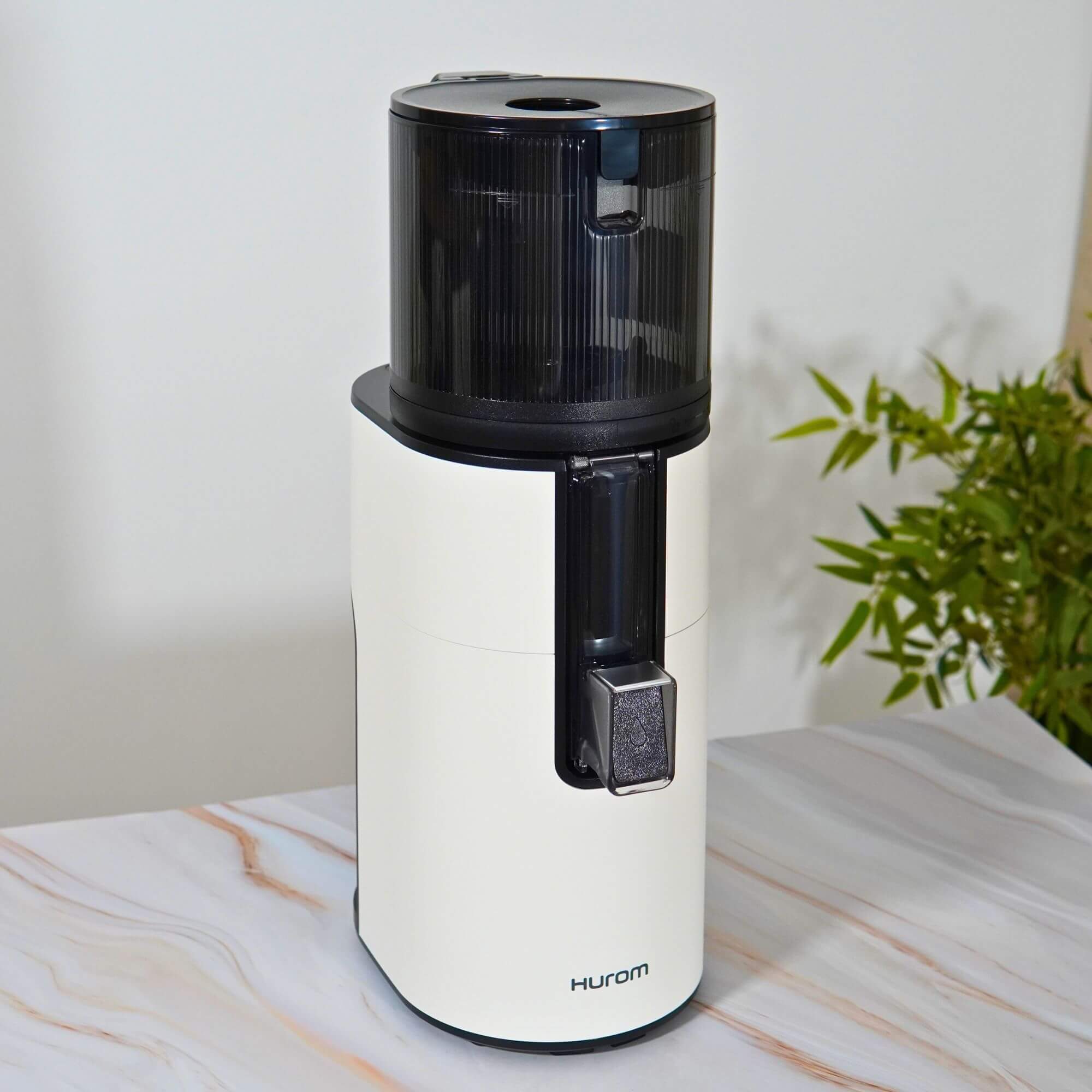
This newer model stands out for its time efficiency, completing the entire process (juicing + cleaning) in just 4 minutes and 23 seconds.
The juice yield is slightly lower (326ml initial, 314ml strained) compared to other models, and the higher 90 RPM speed does introduce more oxidation.
However, its quick cleanup time of 1:51 is a significant advantage for daily use.
The self-feeding system works well with celery, though the higher RPM can sometimes cause pieces to bounce around in the feeding chamber.
Hurom H310A
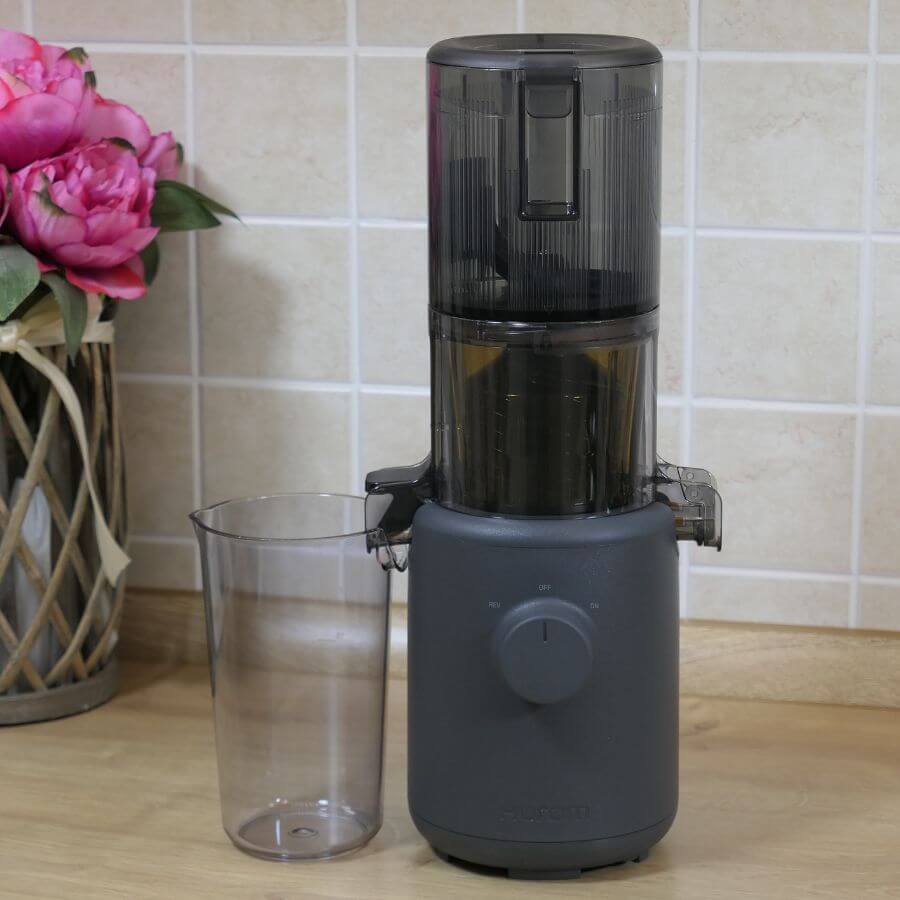
With the highest initial juice yield (384ml), the H310A might look like the best choice at first. However, there are some important things to consider.
The narrow pulp exit requires cutting celery into smaller pieces to prevent clogging, which actually helps squeeze out more juice but also introduces more pulp (364ml after straining).
While it’s the quietest model tested (66 dB) and easy to clean (1:51), the long juicing time (5:58) and extra prep work might be deal-breakers for some.
Its compact size makes it great for smaller kitchens, but you’ll need to invest more time in preparation.
Hurom GI

The GI stands out as Hurom’s only horizontal juicer, specifically designed for celery and leafy greens. While it excels at juicing leafy greens, I found other models performed better with celery, especially if you plan to juice a variety of ingredients.
A unique advantage of the GI is its ability to handle full celery stalks without chopping – though for consistency in my testing, I cut them into 4-6cm pieces like with other juicers. Performance-wise, it delivers solid results with a reasonable juicing speed (2:24) and good yield (369ml initial, 351ml strained). The juice quality is good, though not quite as clear as the H320N/H330P’s output.
Operating at 73 dB, it’s one of the quieter models in the lineup, and its 2:19 cleaning time is reasonable. The narrow feeding tube requires some prep work – more than the H320N/H330P but less than the H310A.
While it may not lead in any single category, it offers consistent, reliable performance across all parameters.
I’m Alen, the founder of JuiceNext.com, and I’ve been immersed in the world of juicing for over 4 years now.
As an electrical engineer, I bring a unique, analytical perspective to my juicer reviews. I personally test each juicer, focusing on their efficiency and performance.
My commitment is to provide unbiased, detailed reviews and original recipes to help you make informed decisions. When I’m not in the kitchen experimenting with new juice combinations, you’ll find me hiking or bike riding – activities that perfectly complement my passion for healthy living and juicing.
Given my background in electrical engineering, you might notice that I tend to include a lot of technical information in my juicer reviews. My ultimate goal is threefold: offer my honest thoughts on currently available juicers, and keep you informed about juicer promotions and discounts.







